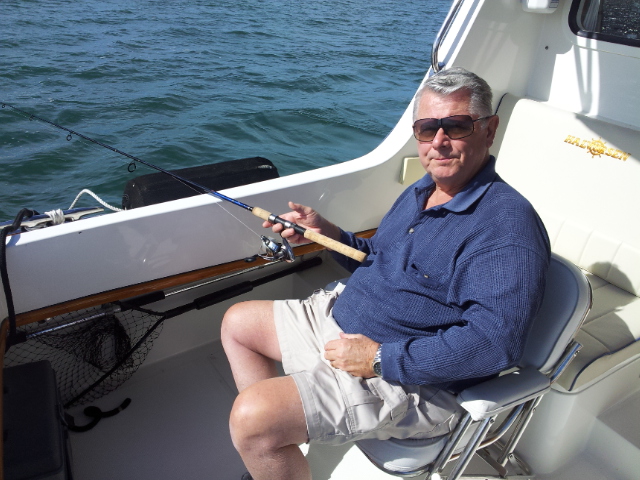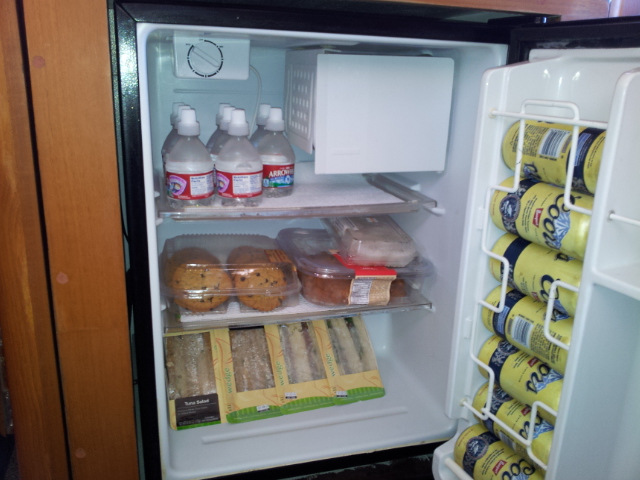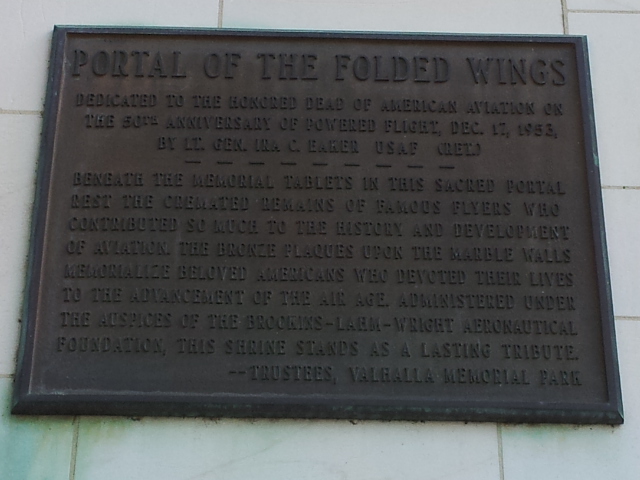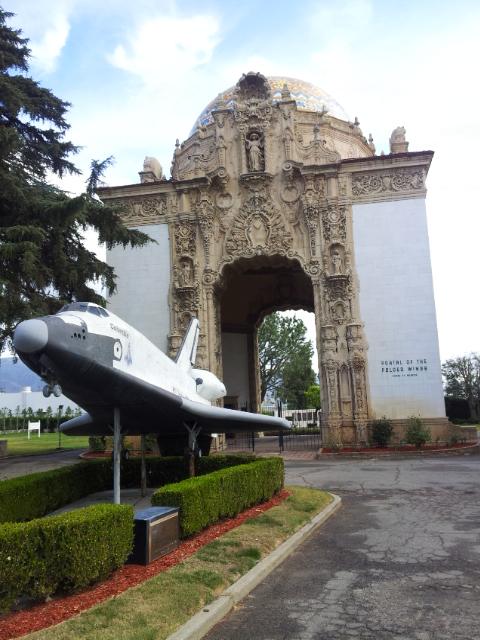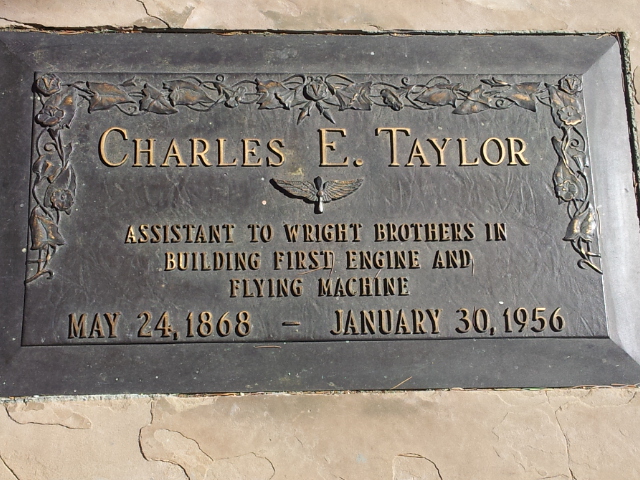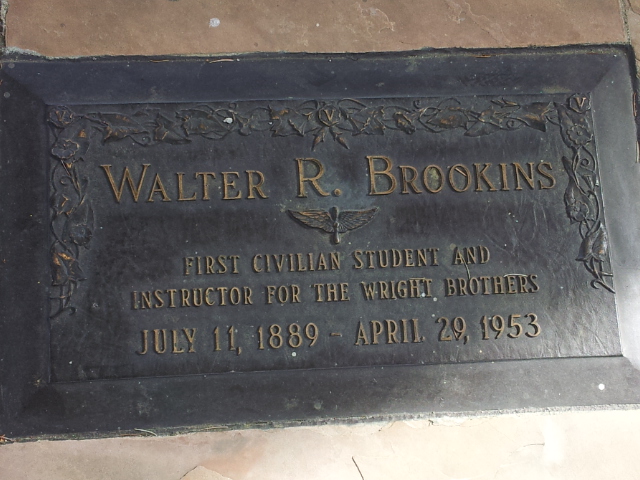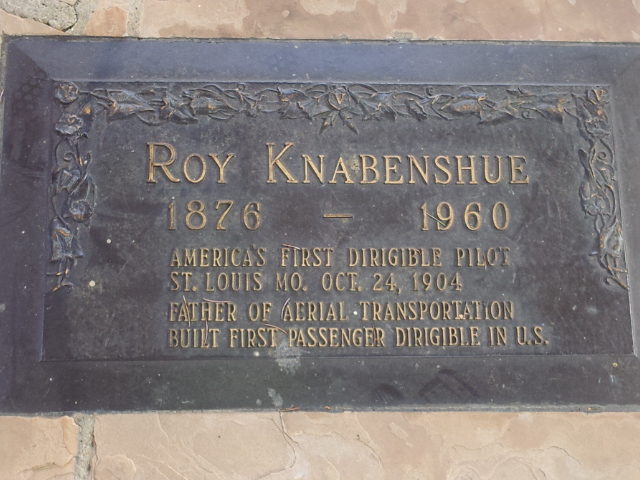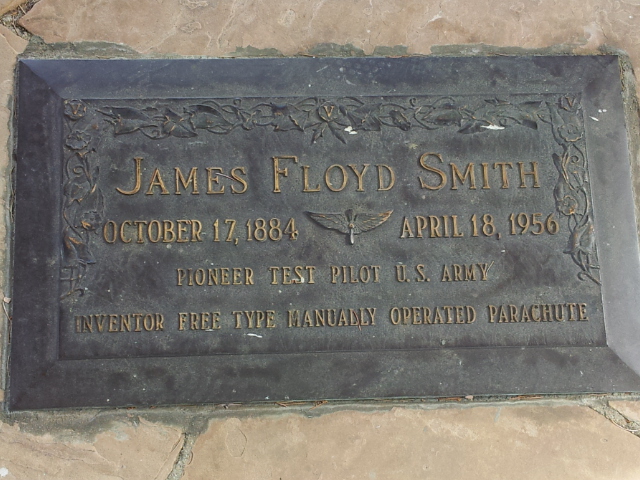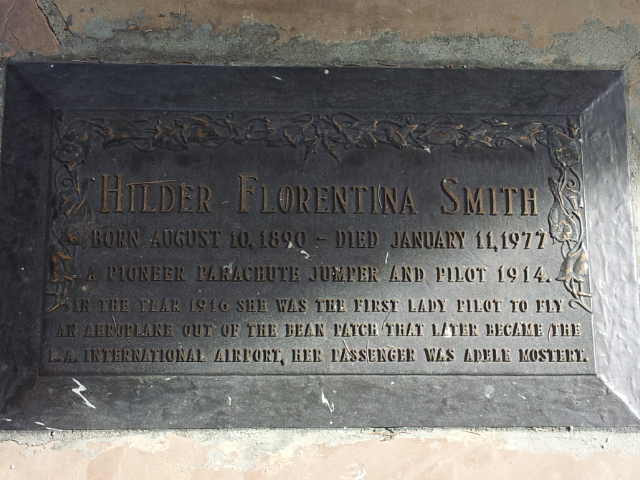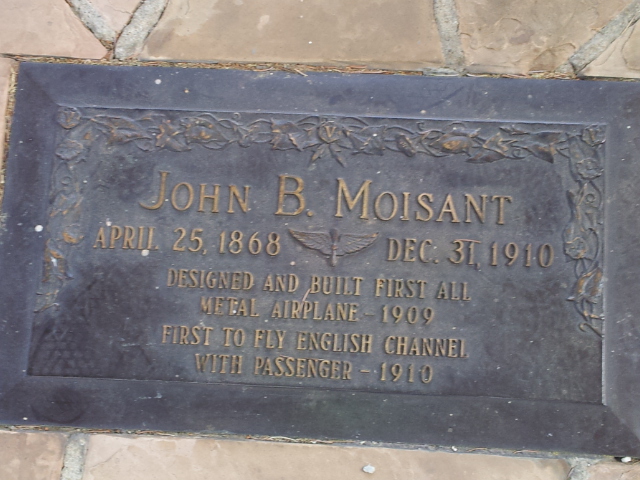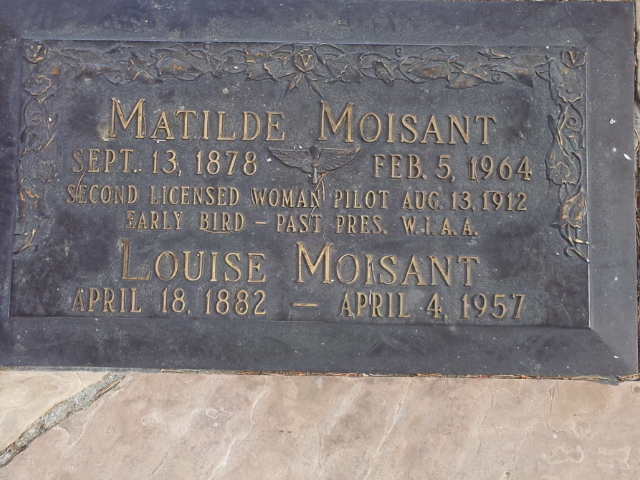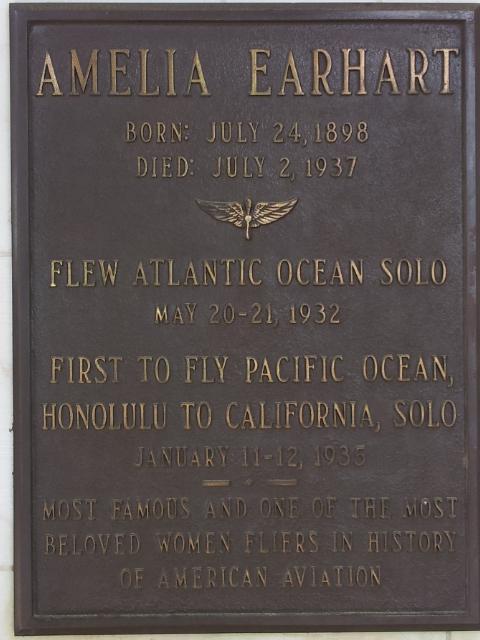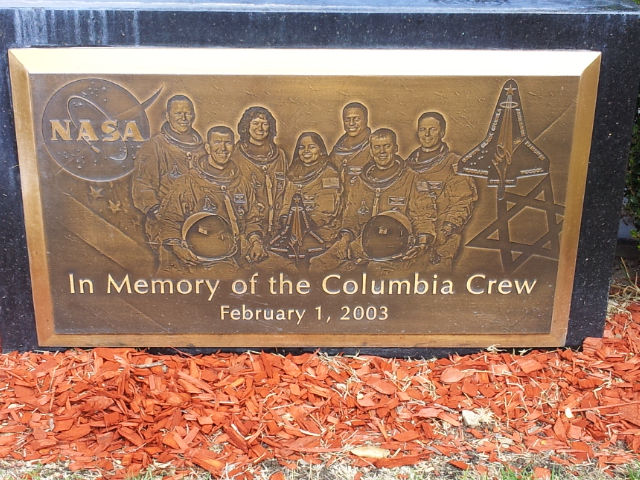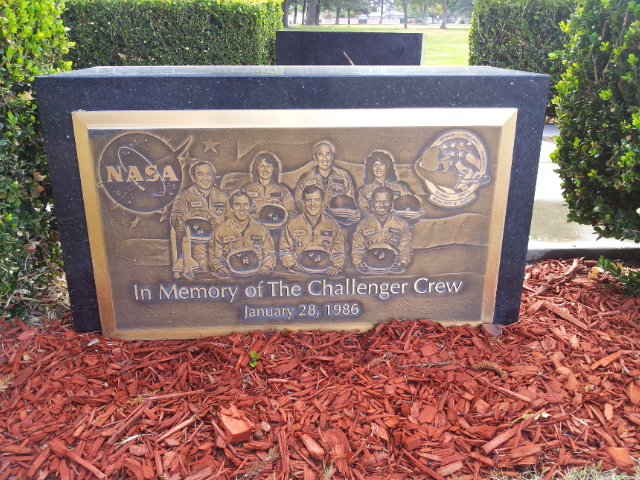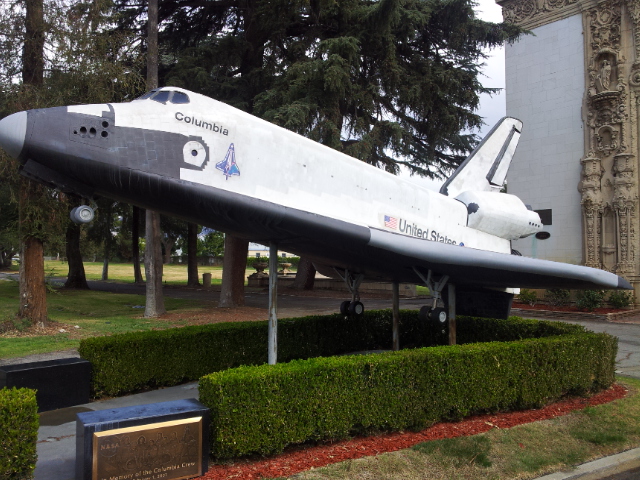BaltimoreLurker
Curmudgeon
- Joined
- Oct 8, 2007
- Messages
- 2,775
- Location
- USA
- Vessel Name
- Moon Dance
- Vessel Make
- 1974 34' Marine Trader Sedan
By Charles E. Taylor, as told to Robert S. Hall
When Orville Wright died Jan. 30, 1948, Charles E. Taylor became the only surviving member of the three who built the first airplane. Charlie Taylor was the only employee and intimate associate of Wilbur and Orville Wright throughout the critical years. Without precedent or fanfare, Taylor built the engines for the Wright's first planes.
This article, written in 1948 while Taylor was living in retirement in California, was first published inCollier's, Dec. 25, 1948, and was reprinted in Air Line Pilot, December 1978. Taylor died Jan. 30, 1956, at the age of 88.
It was a hot June night in Dayton. It must have been a Saturday because I was at the Wright Cycle Company gassing with Wilbur and Orville.They used to stay open Saturdaynights to take care of the folks who worked all week and couldn't get around any other time.
One of the brothers, I forget which, asked me how would I like to go to work for them. There were just the two of them in the shop, and they said they needed another hand. They offered me $18 a week. That was pretty good money; it figured to 30 cents an hour [Editor's note: Taylor 's statement implies a 60-hour work week.]I was making 25 cents at the Dayton Electric Company, which was about the same as all skilled machinists were getting.
I was a machinist and had done job work for the boys in my own shop. Once I made up a coaster brake they had invented, but they dropped it later. I knew they were interested in box kites and gliders, and that they had gone south to Kitty Hawk, N.C., in 1900 with a glider. I didn't know anything about the stuff, but I did know something about the bicycle business.
The Wright shop was only six blocks from where I lived and I could bicycle to lunch. Besides, I liked the Wrights. So I said all right, and I reported in on June 15. That was in 1901.
Three weeks after I went to work for the Wrights, they took off for the South with another glider. I was alone in charge of their bicycle company. They trusted me to handle not only their customers but their money.
When they returned that year, they decided to build a small wind tunnel to test out some of their theories on wings and control surfaces. We made a rectangular-shaped box with a fan at one end powered by the stationary gas engine they had built to drive the lathe, drill press, and band saw. I ground down some old hacksaw blades for them to use in making balances for the tunnel. Nowadays, wind tunnels run into the millions of dollars, and some are big enough to hold full-scale airplanes. That was the first work they asked me to do in connection with their flying experiments.
For a long while, though, I was kept busy enough repairing bicycles and waiting on customers. The Wrights did most of their experimenting upstairs where they had a small office and workroom. I worked in the shop in the back room on the first floor.
Part of my job was to open up at 7 a.m. They would get in a little later, between 8 and 9 a.m. We all stayed until closing time at 6 p.m. We went home for lunch, but at different times so we didn't have to close the shop. Their father, Milton Wright, was a bishop in the United Brethren Church, and the boys never worked on Sunday.
So far as I can figure out, Will and Orv hired me to worry about their bicycle business so they could concentrate on their flying studies and experiments. I suppose the more of the routine work I shouldered, the faster they were able to get on with their pet project, and I must have satisfied them for they didn't hire anyone else for eight years.
If they had any idea in June 1901 that someday they'd be making a gasoline internal-combustion engine for an airplane and would need some first-rate machine work for it, they sure didn't say anything about it to me.
But when they returned from the South in 1902, they said they were through with gliders and were going to try a powered machine. They figured they'd need a larger machine to carry the motor, and they started work on the new biplane right away. At the same time they tried to locate a motor. Nothing turned up.
So they decided to build one of their own. They figured on four cylinders and estimated the bore and stroke at four inches. While the boys were handy with tools, they had never done much machine work, and anyway they were busy on the airframe. It was up to me. My only experience with a gasoline engine was an attempt to repair one in an automobile in 1901.
The first engine
We didn't make any drawings. One of us would sketch out the part we were talking about on a piece of scratch paper, and I'd spike the sketch over my bench. It took me six weeks to make that engine. The only metal-working machines we had were a lathe and a drill press, run by belts from the stationary gas engine.
The crankshaft was made out of a block of machine steel 6 by 31 inches and 15/8 inch thick. I traced the outline on the slab, then drilled through with the drill press until I could knock out the surplus pieces with a hammer and chisel. Then I put it in the lathe and turned it down to size and smoothness.
The body of the first engine was of cast aluminum and was bored out on the lathe for independent cylinders. The pistons were cast iron, and these were turned down and grooved for piston rings.
The completed engine weighed 180 pounds and developed 12 horsepower at 1,025 revolutions per minute.
While I was doing all this work on the engine, Will and Orv were busy upstairs working on the airframe. They asked me to make the metal parts, such as the small fittings where the wooden struts joined the spars and the truss wires were attached. There weren't any turnbuckles in the truss wires, so the fit had to be just so. It was so tight we had to force the struts into position.
The fuel system was simple. A one-gallon fuel tank was suspended from a wing strut, and the gasoline fed by gravity down a tube to the engine. The fuel valve was an ordinary gaslight pet cock. There was no carburetor as we know it today. The fuel was fed into a shallow chamber in the manifold. Raw gas blended with air in this chamber, which was next to the cylinders and heated up rather quickly, this helping to vaporize the mixture. The engine was started by priming each cylinder with a few drops of raw gas.
The ignition was the make-and-break type. No spark plugs. The spark was made by the opening and closing of two contact points inside the combustion chamber. These were operated by shafts and cams geared to the main camshaft. The ignition switch was an ordinary single-throw knife switch we bought at the hardware store. Dry batteries were used for starting the engine, and then we switched onto a magneto bought from the Dayton Electric Company. There was no battery on the plane.
Several lengths of speaking tube, such as you find in apartment houses, were used in the radiator.
The chains to drive the propeller shafts were specially made by the Indianapolis Chain Company, but the sprockets came ready-made. Roebling wire was used for the trusses.
Propellers
I think the hardest job Will and Orv had was with the propellers. I don't believe they were ever given enough credit for that development. They had read up on all that was published about boat propellers, but they couldn't find any formula for what they needed. So they had to develop their own, and this they did in the wind tunnel.
They concluded that an air propeller was really just a rotating wing, and by experimenting in the wind box, they arrived at the design they wanted. They made the propellers out of three lengths of wood, glued together at staggered intervals. Then they cut them down to the right size and shape with a hatchet and drawshave. They were good propellers.
We never did assemble the whole machine at Dayton . There wasn't room enough in the shop. When the center section was assembled, it blocked the passage between the front and back rooms, and the boys had to go out the side door and around to the front to wait on the customers.
We still had bicycle customers. The Wright brothers had to keep the business going to pay for the flying experiments. There wasn't any other money. While the boys always worked hard and there never was any horseplay around the shop, they always seemed to find time to stop and talk with a customer or humor the neighborhood children who wandered in. Sometimes I think the kids were the only ones who really believed that Will and Orv would fly. They hadn't learned enough to say it couldn't be done.
We block-tested the motor before crating it for shipment to Kitty Hawk. We rigged up a resistance fan with blades an inch and a half wide and five feet two inches long. The boys figured out the horsepower by counting the revolutions per minute. Those two sure knew their physics. I guess that's why they always knew what they were doing and hardly ever guessed at anything.
We finally got everything crated and on the train. There was no ceremony about it, even among ourselves The boys had been making these trips for four years, and this was the third time I had been left to run the shop. If there was any worry about the flying machine not working, they never showed it and I never felt it.
You know, it's a funny thing, but I'm not sure just how or when I learned that Will and
Orv had actually flown the machine. They sent a telegram to their father saying they had made four successful powered flights that day--Dec. 17, 1903--and would be home for Christmas.
I suppose their sister, Katherine, or maybe the bishop came over and told me about it I know I thought it was pretty nice that they had done what they set out to do, and I was glad to hear that the motor ran all right. But I don't remember doing any jig steps. The boys were always so matter-of-fact about things, and they never made an effort to get me excited.
Even when they got home there was no special celebration in the shop. Of course they were pleased with the flights. But their first word with me, as I remember, was about the motor being damaged when the wind picked up the machine and turned it topsy-turvy after Wilbur had completed the fourth flight. They wanted a new one built right away. And they were concerned with making improvements in the controls. They were always thinking of the next thing to do; they didn't waste much time worrying about the past.
Will and Orv
The Wrights didn't go into the airplane experiment with the idea of making a lot of money. They just seemed to be curious about the problems involved--I suppose you would call it a challenge--and they were determined to find out why they couldn't make it work. It was not a game with them or a sport. It may have been a hobby at the start, but now it was a serious business.
I was happy working for Will and Orv, and I know they were pleased with my work. They showed it in many ways. Orville even left me an $800 annuity in his will. When I finally left his employ in 1919, he could have forgotten about me then and there. But the fact he did not helps me believe he appreciated that I had a part in giving the airplane to the world, though nobody made any fuss about it, and I didn't either.
Will and Orv were always thoughtful at Christmastime. The second year I was with them they gave me a two-inch micrometer. Another year it was a one-foot scale. And one Christmas they gave me a $10 gold piece.
People have asked me if I knew why neither Wilbur nor Orville ever married, particularly since their older brothers, Reuchlin and Lorin, and their sister, Katherine, did. I'm sure I never asked them, but I remember that Orv used to say it was up to Will to marry first because he was the older of the two. And Will kept saying he didn't have time for a wife. But I think he was just woman-shy--young women, at least.
He would get awfully nervous when young women were around. When we began operating at Simms Station on the outskirts of Dayton in 1904, we always went out on the traction cars. If an older woman sat down beside him, before you knew it they would be talking; and if she got off at our stop, he'd carry her packages and you'd think he had known her all his life. But if a young woman sat next to him, he would begin to fidget, and pretty soon he would get up and go stand on the platform until it was time to leave the car.
I don't recall that Orville was that shy, but after Wilbur died I guess he just didn't feel like getting married. I think both the boys were mentally flying all the time and simply didn't think about girls.
They were both fond of children, though. Orville, especially, was quite a hand with kids. He used to make toys in the shop and give them away. Later, he designed a little wooden man on a flying trapeze and licensed some company to make it.
The Wrights didn't drink or smoke, but they never objected too much to my cigar smoking. I used to smoke around 25 cigars a day. Once I walked down the street with three cigars going at once--you know how a young fellow does crazy things once in a while.
Both the boys had tempers, but no matter how angry they ever got, I never heard them use a profane word. I never swore myself, and to this day I can't think of a time I ever let go with anything stronger than heckety-hoo. The boys were working out a lot of theory in those days, and occasionally they would get into terrific arguments. They'd shout at each other something terrible. I don't think they really got mad, but they sure got awfully hot.
One morning following the worst argument I ever heard, Orv came in and said he guessed he'd been wrong and they ought to do it Will's way. A few minutes later Will came in and said he'd been thinking it over and perhaps Orv was right. First thing I knew they were arguing the thing all over again, only this time they had switched ideas. When they were through, they knew where they were and could go ahead with the job.
It was Orville who gave me my first flight. He first offered me a hop in 1908 at Fort Myer , Va. , when we were demonstrating the Wright airplane for the first Army contract. I was in the passenger's seat, and we were preparing to take off when a high-ranking officer asked Orville if he would mind taking along an Army observer instead.
Naturally I got out, and Lt. Thomas E. Selfridge took my place. The machine crashed shortly after takeoff. Lt. Selfridge was killed, and Orville was seriously injured. Lt. Selfridge was the first military air casualty. Since then, a lot of people say they have narrowly avoided being killed in airplanes by a last-minute switch in plans. Maybe I was the first.
In May 1910, Orv finally took me up. It was at Simms Station, and he did what a lot of pilots have done in later years with their first-flight passengers. He tried to give me a scare. We were flying around over the field when suddenly the plane began to pitch violently. I grabbed hold of a strut and looked over at Orv. He didn't seem upset, although he appeared to be having a hard time controlling the machine Pretty soon the pitching stopped and we landed. Orv asked me if I was scared. I said, "No, if you weren't, why should I be?" He thought it was very funny.
I always wanted to learn to fly, but I never did. The Wrights refused to teach me and tried to discourage the idea. They said they needed me in the shop and to service their machines, and if I learned to fly, I'd be gadding about the country and maybe become an exhibition pilot and they'd never see me again.
One of my jobs that summer of 1904 was as sort of airport manager at the Huffman Prairie, located about eight miles east of Dayton at Simms Station. I suppose it was the first airport in the country, with all due respect to the sands of Kitty Hawk. It was a small pasture the boys had arranged to use.
We built a shed for the machine and a catapult to assist in the takeoffs, because the field was small and rough. It was made up of a wooden track and a tower at the starting end. We drew heavy weights to the top of the tower on ropes that were rigged through pulleys to the bottom of the tower, out to the takeoff end of the track and back to the airplane. When the weights were released, the machine would dart forward.
We were all very busy out at Simms Station that summer testing the new airplane we built to replace the Kitty Hawk machine. We scarcely had time to keep the bicycle business going, and by the following summer, the boys gave it up entirely.
I must have built half-a-dozen engines for the boys before the airplane company was formed in 1909 and they took on additional help. The brothers also had me doing repair work on the airframe, and as they began to travel around to demonstrate the machines, it was up to me to help with the crating, uncrating, and assembling.
Big business
After the company was started in 1909, the place was expanded, more men were hired, and I was put in charge of the engine shop with men working under me. Some of the personal feeling of the old days, when there were just the three of us, was gone. It was beginning to be big business. We had lots of orders, and the first plane sold for private use was to Robert J. Collier. He was a close friend of Wilbur and Orville and owned stock in the company.
Then Calbraith Perry Rodgers came down to Dayton in 1911 to see about the machine he had ordered for his proposed transcontinental flight and offered me $10 a day plus expenses to be his mechanic on the trip. At the time my wages were $25 a week. I told him I'd go; then I told Orv about it. He asked me not to quit. I told him I had already given my word to Rodgers and couldn't very well back out. He told me to make it a sort of leave of absence, and to be sure and come back.
Rodgers left the race track at Sheepshead Bay, Long Island, on September 17and reached Long Beach, Calif., 47 days later. It was my job to care for the plane every night and make repairs after every mishap. I traveled on a special train that accompanied the flight. Rodgers failed to win the $50,000 prize posted by William Randolph Hearst because he took longer than 30 days to make the crossing. But it was the first coast-to-coast flight.
Because my wife took ill in California, I didn't get back to the East again until fall of 1912. I found it wasn't like old times. Wilbur had died from typhoid fever on May 30, and there were a lot of new faces around the Wright plant. The pioneering days seemed about over for me.
Maybe that's why that Christmas of 1912 stands out in my memory. It wasn't going to be a very happy one, for either the Wrights or the Taylors. Christmas Eve there came a knock on the door, and there was Orville with a big basket filled with everything for a big Christmas dinner. He just handed me the basket, wished us a "Merry Christmas," and went away. It was the first time he had ever come to our house.
I stayed on with Orville after he sold the company and retired to his laboratory in 1915. I helped out with some of his inventions and experiments and kept his car in good running order. But there was less and less work to do, and finally I got restless and took a job downtown with the Dayton-Wright Company in 1919.
In 1916, we took the Flyer out of storage and fixed it up for its first exhibition at the Massachusetts Institute of Technology in Cambridge. If it hadn't been for Roy Knabenshue, there might not have been the historic relic to exhibit there or in Washington now. Roy tells how he approached Wilbur early in 1912 and asked him what he was going to do with theFlyer, and Wilbur told him, "Oh, I guess we'll burn it; it's worthless." Roy argued it was historic and finally talked him out of destroying the plane.
It was then forgotten until Orville got this request to show it in Massachusetts . It came from Lester D. Gardner (then publisher ofAviation magazine, later an officer in the Army Air Service in World War I and founder of the Institute of the Aeronautical Sciences), who was in charge of the aeronautical part of the dedication program of the new buildings of MIT at Cambridge. Orville was reluctant at first, but consented when Gardner and Roy convinced him how interesting it would be to the public.
Orville and I continued to see each other frequently after 1919. He used to bring odd jobs to me at the plant where I was working, and I would visit him at his laboratory. Then in 1928 I moved to California and didn't see him again until 1937.
I got work in a machine shop in Los Angeles, and then the big Depression hit us. I was out of work but had saved some money. I invested this in 336 lots in a new land development on the edge of the Salton Sea, down in the southern California desert. I built a little house and sat around waiting for something to happen. Nothing did.
In 1937 Henry Ford hired me to help restore the original Wright home and shop when he moved them to his Greenfield Village museum at Dearborn, Mich. They were installed near the first Ford workshop and Thomas Edison's original laboratory. I helped Fred Black, the director of the project, track down the original machinery and furniture, and then I built a replica of the first Wright engine. The home and shop were dedicated in April 1938 with all the big names in aviation on hand.
I met Orville often during this period, both in Dayton and in Dearborn. When I left the village to return to California in 1941, I called on him in Dayton. That was the last time I saw him, but he wrote me regularly about his work and I kept him posted on what I did. He wrote every December 17. It was sort of a personal anniversary with us, and it was also a Christmas message.
I always wanted to go back into the laboratory with Orville. He hinted at it in some of his letters--saying he needed expert workmanship on his projects--but he never came right out and asked me. I had intended to go back East this past summer if my old pump would let me, but Orville died on January 30.
In the last note I got from him, shortly before he died, he wrote: "I hope you are well and enjoying life: but that's hard to imagine when you haven't much work to do." It was signed, "Orv."
He knew me pretty well.
When Orville Wright died Jan. 30, 1948, Charles E. Taylor became the only surviving member of the three who built the first airplane. Charlie Taylor was the only employee and intimate associate of Wilbur and Orville Wright throughout the critical years. Without precedent or fanfare, Taylor built the engines for the Wright's first planes.
This article, written in 1948 while Taylor was living in retirement in California, was first published inCollier's, Dec. 25, 1948, and was reprinted in Air Line Pilot, December 1978. Taylor died Jan. 30, 1956, at the age of 88.
It was a hot June night in Dayton. It must have been a Saturday because I was at the Wright Cycle Company gassing with Wilbur and Orville.They used to stay open Saturdaynights to take care of the folks who worked all week and couldn't get around any other time.
One of the brothers, I forget which, asked me how would I like to go to work for them. There were just the two of them in the shop, and they said they needed another hand. They offered me $18 a week. That was pretty good money; it figured to 30 cents an hour [Editor's note: Taylor 's statement implies a 60-hour work week.]I was making 25 cents at the Dayton Electric Company, which was about the same as all skilled machinists were getting.
I was a machinist and had done job work for the boys in my own shop. Once I made up a coaster brake they had invented, but they dropped it later. I knew they were interested in box kites and gliders, and that they had gone south to Kitty Hawk, N.C., in 1900 with a glider. I didn't know anything about the stuff, but I did know something about the bicycle business.
The Wright shop was only six blocks from where I lived and I could bicycle to lunch. Besides, I liked the Wrights. So I said all right, and I reported in on June 15. That was in 1901.
Three weeks after I went to work for the Wrights, they took off for the South with another glider. I was alone in charge of their bicycle company. They trusted me to handle not only their customers but their money.
When they returned that year, they decided to build a small wind tunnel to test out some of their theories on wings and control surfaces. We made a rectangular-shaped box with a fan at one end powered by the stationary gas engine they had built to drive the lathe, drill press, and band saw. I ground down some old hacksaw blades for them to use in making balances for the tunnel. Nowadays, wind tunnels run into the millions of dollars, and some are big enough to hold full-scale airplanes. That was the first work they asked me to do in connection with their flying experiments.
For a long while, though, I was kept busy enough repairing bicycles and waiting on customers. The Wrights did most of their experimenting upstairs where they had a small office and workroom. I worked in the shop in the back room on the first floor.
Part of my job was to open up at 7 a.m. They would get in a little later, between 8 and 9 a.m. We all stayed until closing time at 6 p.m. We went home for lunch, but at different times so we didn't have to close the shop. Their father, Milton Wright, was a bishop in the United Brethren Church, and the boys never worked on Sunday.
So far as I can figure out, Will and Orv hired me to worry about their bicycle business so they could concentrate on their flying studies and experiments. I suppose the more of the routine work I shouldered, the faster they were able to get on with their pet project, and I must have satisfied them for they didn't hire anyone else for eight years.
If they had any idea in June 1901 that someday they'd be making a gasoline internal-combustion engine for an airplane and would need some first-rate machine work for it, they sure didn't say anything about it to me.
But when they returned from the South in 1902, they said they were through with gliders and were going to try a powered machine. They figured they'd need a larger machine to carry the motor, and they started work on the new biplane right away. At the same time they tried to locate a motor. Nothing turned up.
So they decided to build one of their own. They figured on four cylinders and estimated the bore and stroke at four inches. While the boys were handy with tools, they had never done much machine work, and anyway they were busy on the airframe. It was up to me. My only experience with a gasoline engine was an attempt to repair one in an automobile in 1901.
The first engine
We didn't make any drawings. One of us would sketch out the part we were talking about on a piece of scratch paper, and I'd spike the sketch over my bench. It took me six weeks to make that engine. The only metal-working machines we had were a lathe and a drill press, run by belts from the stationary gas engine.
The crankshaft was made out of a block of machine steel 6 by 31 inches and 15/8 inch thick. I traced the outline on the slab, then drilled through with the drill press until I could knock out the surplus pieces with a hammer and chisel. Then I put it in the lathe and turned it down to size and smoothness.
The body of the first engine was of cast aluminum and was bored out on the lathe for independent cylinders. The pistons were cast iron, and these were turned down and grooved for piston rings.
The completed engine weighed 180 pounds and developed 12 horsepower at 1,025 revolutions per minute.
While I was doing all this work on the engine, Will and Orv were busy upstairs working on the airframe. They asked me to make the metal parts, such as the small fittings where the wooden struts joined the spars and the truss wires were attached. There weren't any turnbuckles in the truss wires, so the fit had to be just so. It was so tight we had to force the struts into position.
The fuel system was simple. A one-gallon fuel tank was suspended from a wing strut, and the gasoline fed by gravity down a tube to the engine. The fuel valve was an ordinary gaslight pet cock. There was no carburetor as we know it today. The fuel was fed into a shallow chamber in the manifold. Raw gas blended with air in this chamber, which was next to the cylinders and heated up rather quickly, this helping to vaporize the mixture. The engine was started by priming each cylinder with a few drops of raw gas.
The ignition was the make-and-break type. No spark plugs. The spark was made by the opening and closing of two contact points inside the combustion chamber. These were operated by shafts and cams geared to the main camshaft. The ignition switch was an ordinary single-throw knife switch we bought at the hardware store. Dry batteries were used for starting the engine, and then we switched onto a magneto bought from the Dayton Electric Company. There was no battery on the plane.
Several lengths of speaking tube, such as you find in apartment houses, were used in the radiator.
The chains to drive the propeller shafts were specially made by the Indianapolis Chain Company, but the sprockets came ready-made. Roebling wire was used for the trusses.
Propellers
I think the hardest job Will and Orv had was with the propellers. I don't believe they were ever given enough credit for that development. They had read up on all that was published about boat propellers, but they couldn't find any formula for what they needed. So they had to develop their own, and this they did in the wind tunnel.
They concluded that an air propeller was really just a rotating wing, and by experimenting in the wind box, they arrived at the design they wanted. They made the propellers out of three lengths of wood, glued together at staggered intervals. Then they cut them down to the right size and shape with a hatchet and drawshave. They were good propellers.
We never did assemble the whole machine at Dayton . There wasn't room enough in the shop. When the center section was assembled, it blocked the passage between the front and back rooms, and the boys had to go out the side door and around to the front to wait on the customers.
We still had bicycle customers. The Wright brothers had to keep the business going to pay for the flying experiments. There wasn't any other money. While the boys always worked hard and there never was any horseplay around the shop, they always seemed to find time to stop and talk with a customer or humor the neighborhood children who wandered in. Sometimes I think the kids were the only ones who really believed that Will and Orv would fly. They hadn't learned enough to say it couldn't be done.
We block-tested the motor before crating it for shipment to Kitty Hawk. We rigged up a resistance fan with blades an inch and a half wide and five feet two inches long. The boys figured out the horsepower by counting the revolutions per minute. Those two sure knew their physics. I guess that's why they always knew what they were doing and hardly ever guessed at anything.
We finally got everything crated and on the train. There was no ceremony about it, even among ourselves The boys had been making these trips for four years, and this was the third time I had been left to run the shop. If there was any worry about the flying machine not working, they never showed it and I never felt it.
You know, it's a funny thing, but I'm not sure just how or when I learned that Will and
Orv had actually flown the machine. They sent a telegram to their father saying they had made four successful powered flights that day--Dec. 17, 1903--and would be home for Christmas.
I suppose their sister, Katherine, or maybe the bishop came over and told me about it I know I thought it was pretty nice that they had done what they set out to do, and I was glad to hear that the motor ran all right. But I don't remember doing any jig steps. The boys were always so matter-of-fact about things, and they never made an effort to get me excited.
Even when they got home there was no special celebration in the shop. Of course they were pleased with the flights. But their first word with me, as I remember, was about the motor being damaged when the wind picked up the machine and turned it topsy-turvy after Wilbur had completed the fourth flight. They wanted a new one built right away. And they were concerned with making improvements in the controls. They were always thinking of the next thing to do; they didn't waste much time worrying about the past.
Will and Orv
The Wrights didn't go into the airplane experiment with the idea of making a lot of money. They just seemed to be curious about the problems involved--I suppose you would call it a challenge--and they were determined to find out why they couldn't make it work. It was not a game with them or a sport. It may have been a hobby at the start, but now it was a serious business.
I was happy working for Will and Orv, and I know they were pleased with my work. They showed it in many ways. Orville even left me an $800 annuity in his will. When I finally left his employ in 1919, he could have forgotten about me then and there. But the fact he did not helps me believe he appreciated that I had a part in giving the airplane to the world, though nobody made any fuss about it, and I didn't either.
Will and Orv were always thoughtful at Christmastime. The second year I was with them they gave me a two-inch micrometer. Another year it was a one-foot scale. And one Christmas they gave me a $10 gold piece.
People have asked me if I knew why neither Wilbur nor Orville ever married, particularly since their older brothers, Reuchlin and Lorin, and their sister, Katherine, did. I'm sure I never asked them, but I remember that Orv used to say it was up to Will to marry first because he was the older of the two. And Will kept saying he didn't have time for a wife. But I think he was just woman-shy--young women, at least.
He would get awfully nervous when young women were around. When we began operating at Simms Station on the outskirts of Dayton in 1904, we always went out on the traction cars. If an older woman sat down beside him, before you knew it they would be talking; and if she got off at our stop, he'd carry her packages and you'd think he had known her all his life. But if a young woman sat next to him, he would begin to fidget, and pretty soon he would get up and go stand on the platform until it was time to leave the car.
I don't recall that Orville was that shy, but after Wilbur died I guess he just didn't feel like getting married. I think both the boys were mentally flying all the time and simply didn't think about girls.
They were both fond of children, though. Orville, especially, was quite a hand with kids. He used to make toys in the shop and give them away. Later, he designed a little wooden man on a flying trapeze and licensed some company to make it.
The Wrights didn't drink or smoke, but they never objected too much to my cigar smoking. I used to smoke around 25 cigars a day. Once I walked down the street with three cigars going at once--you know how a young fellow does crazy things once in a while.
Both the boys had tempers, but no matter how angry they ever got, I never heard them use a profane word. I never swore myself, and to this day I can't think of a time I ever let go with anything stronger than heckety-hoo. The boys were working out a lot of theory in those days, and occasionally they would get into terrific arguments. They'd shout at each other something terrible. I don't think they really got mad, but they sure got awfully hot.
One morning following the worst argument I ever heard, Orv came in and said he guessed he'd been wrong and they ought to do it Will's way. A few minutes later Will came in and said he'd been thinking it over and perhaps Orv was right. First thing I knew they were arguing the thing all over again, only this time they had switched ideas. When they were through, they knew where they were and could go ahead with the job.
It was Orville who gave me my first flight. He first offered me a hop in 1908 at Fort Myer , Va. , when we were demonstrating the Wright airplane for the first Army contract. I was in the passenger's seat, and we were preparing to take off when a high-ranking officer asked Orville if he would mind taking along an Army observer instead.
Naturally I got out, and Lt. Thomas E. Selfridge took my place. The machine crashed shortly after takeoff. Lt. Selfridge was killed, and Orville was seriously injured. Lt. Selfridge was the first military air casualty. Since then, a lot of people say they have narrowly avoided being killed in airplanes by a last-minute switch in plans. Maybe I was the first.
In May 1910, Orv finally took me up. It was at Simms Station, and he did what a lot of pilots have done in later years with their first-flight passengers. He tried to give me a scare. We were flying around over the field when suddenly the plane began to pitch violently. I grabbed hold of a strut and looked over at Orv. He didn't seem upset, although he appeared to be having a hard time controlling the machine Pretty soon the pitching stopped and we landed. Orv asked me if I was scared. I said, "No, if you weren't, why should I be?" He thought it was very funny.
I always wanted to learn to fly, but I never did. The Wrights refused to teach me and tried to discourage the idea. They said they needed me in the shop and to service their machines, and if I learned to fly, I'd be gadding about the country and maybe become an exhibition pilot and they'd never see me again.
One of my jobs that summer of 1904 was as sort of airport manager at the Huffman Prairie, located about eight miles east of Dayton at Simms Station. I suppose it was the first airport in the country, with all due respect to the sands of Kitty Hawk. It was a small pasture the boys had arranged to use.
We built a shed for the machine and a catapult to assist in the takeoffs, because the field was small and rough. It was made up of a wooden track and a tower at the starting end. We drew heavy weights to the top of the tower on ropes that were rigged through pulleys to the bottom of the tower, out to the takeoff end of the track and back to the airplane. When the weights were released, the machine would dart forward.
We were all very busy out at Simms Station that summer testing the new airplane we built to replace the Kitty Hawk machine. We scarcely had time to keep the bicycle business going, and by the following summer, the boys gave it up entirely.
I must have built half-a-dozen engines for the boys before the airplane company was formed in 1909 and they took on additional help. The brothers also had me doing repair work on the airframe, and as they began to travel around to demonstrate the machines, it was up to me to help with the crating, uncrating, and assembling.
Big business
After the company was started in 1909, the place was expanded, more men were hired, and I was put in charge of the engine shop with men working under me. Some of the personal feeling of the old days, when there were just the three of us, was gone. It was beginning to be big business. We had lots of orders, and the first plane sold for private use was to Robert J. Collier. He was a close friend of Wilbur and Orville and owned stock in the company.
Then Calbraith Perry Rodgers came down to Dayton in 1911 to see about the machine he had ordered for his proposed transcontinental flight and offered me $10 a day plus expenses to be his mechanic on the trip. At the time my wages were $25 a week. I told him I'd go; then I told Orv about it. He asked me not to quit. I told him I had already given my word to Rodgers and couldn't very well back out. He told me to make it a sort of leave of absence, and to be sure and come back.
Rodgers left the race track at Sheepshead Bay, Long Island, on September 17and reached Long Beach, Calif., 47 days later. It was my job to care for the plane every night and make repairs after every mishap. I traveled on a special train that accompanied the flight. Rodgers failed to win the $50,000 prize posted by William Randolph Hearst because he took longer than 30 days to make the crossing. But it was the first coast-to-coast flight.
Because my wife took ill in California, I didn't get back to the East again until fall of 1912. I found it wasn't like old times. Wilbur had died from typhoid fever on May 30, and there were a lot of new faces around the Wright plant. The pioneering days seemed about over for me.
Maybe that's why that Christmas of 1912 stands out in my memory. It wasn't going to be a very happy one, for either the Wrights or the Taylors. Christmas Eve there came a knock on the door, and there was Orville with a big basket filled with everything for a big Christmas dinner. He just handed me the basket, wished us a "Merry Christmas," and went away. It was the first time he had ever come to our house.
I stayed on with Orville after he sold the company and retired to his laboratory in 1915. I helped out with some of his inventions and experiments and kept his car in good running order. But there was less and less work to do, and finally I got restless and took a job downtown with the Dayton-Wright Company in 1919.
In 1916, we took the Flyer out of storage and fixed it up for its first exhibition at the Massachusetts Institute of Technology in Cambridge. If it hadn't been for Roy Knabenshue, there might not have been the historic relic to exhibit there or in Washington now. Roy tells how he approached Wilbur early in 1912 and asked him what he was going to do with theFlyer, and Wilbur told him, "Oh, I guess we'll burn it; it's worthless." Roy argued it was historic and finally talked him out of destroying the plane.
It was then forgotten until Orville got this request to show it in Massachusetts . It came from Lester D. Gardner (then publisher ofAviation magazine, later an officer in the Army Air Service in World War I and founder of the Institute of the Aeronautical Sciences), who was in charge of the aeronautical part of the dedication program of the new buildings of MIT at Cambridge. Orville was reluctant at first, but consented when Gardner and Roy convinced him how interesting it would be to the public.
Orville and I continued to see each other frequently after 1919. He used to bring odd jobs to me at the plant where I was working, and I would visit him at his laboratory. Then in 1928 I moved to California and didn't see him again until 1937.
I got work in a machine shop in Los Angeles, and then the big Depression hit us. I was out of work but had saved some money. I invested this in 336 lots in a new land development on the edge of the Salton Sea, down in the southern California desert. I built a little house and sat around waiting for something to happen. Nothing did.
In 1937 Henry Ford hired me to help restore the original Wright home and shop when he moved them to his Greenfield Village museum at Dearborn, Mich. They were installed near the first Ford workshop and Thomas Edison's original laboratory. I helped Fred Black, the director of the project, track down the original machinery and furniture, and then I built a replica of the first Wright engine. The home and shop were dedicated in April 1938 with all the big names in aviation on hand.
I met Orville often during this period, both in Dayton and in Dearborn. When I left the village to return to California in 1941, I called on him in Dayton. That was the last time I saw him, but he wrote me regularly about his work and I kept him posted on what I did. He wrote every December 17. It was sort of a personal anniversary with us, and it was also a Christmas message.
I always wanted to go back into the laboratory with Orville. He hinted at it in some of his letters--saying he needed expert workmanship on his projects--but he never came right out and asked me. I had intended to go back East this past summer if my old pump would let me, but Orville died on January 30.
In the last note I got from him, shortly before he died, he wrote: "I hope you are well and enjoying life: but that's hard to imagine when you haven't much work to do." It was signed, "Orv."
He knew me pretty well.


